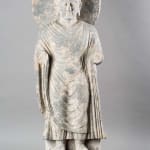Gandhara Schist stone sculpture of the Buddha, 200 CE - 500 CE
Schist
CB.3408
Further images
Gandhara’s geographical position, situated between the Persian world to the west and the Indian to the east, ensured that it was open to a wide variety of artistic influences. Often...
Gandhara’s geographical position, situated between the Persian world to the west and the Indian to the east, ensured that it was open to a wide variety of artistic influences. Often described as a ‘cultural melting pot,’ its strategic importance left it vulnerable to attack. Briefly in the hands of Alexander the Great between 327 -326 B.C., Greek artistic conventions long played an important role in local production. However whilst Gandhara clearly came under the influence of an extraordinary wide range of outside influences, it was also an exporter of ideas. This is most apparent in relation to the spread of Buddhism from India into other parts of Asia. Gandharan monks and scribes were particularly active in areas of China. According to tradition Buddhism was first introduced into the Gandharan region under the patronage of Asoka, emperor of the Mauryan dynasty, in the third century B.C. The first significant physical remains to survive, including stupas and figurative sculpture, date from the first century B.C. Between c.100-400 A.D. sculptors working in schist, terracotta and stucco produced an astonishing number and variety of Buddhist images.
This magnificent Gandharan schist stone sculpture depicts the Buddha Shakyamuni. Standing solemnly with a halo on his back, the Buddha gazes down upon the earth with mercy and compassion. He has a loop topknot, covering the ushnisha which symbolises immense wisdom. While the Buddha wears a simple yet elegant monastic robe, incised lines has been added to suggest the folds of the cloth. His left hand holds a part of the robe, while his right, although missing, should have formed the abhya (no-fear) gesture. The pedestal under his feet is adorned by lotus flowers on all sides. This style has become a tradition of depicting a standing Buddha, largely adopted by Southeast Asian artisans. The extension of the pedestal platform hints at the possibility that this figure might be originally a part of a grand narrative relief.
This magnificent Gandharan schist stone sculpture depicts the Buddha Shakyamuni. Standing solemnly with a halo on his back, the Buddha gazes down upon the earth with mercy and compassion. He has a loop topknot, covering the ushnisha which symbolises immense wisdom. While the Buddha wears a simple yet elegant monastic robe, incised lines has been added to suggest the folds of the cloth. His left hand holds a part of the robe, while his right, although missing, should have formed the abhya (no-fear) gesture. The pedestal under his feet is adorned by lotus flowers on all sides. This style has become a tradition of depicting a standing Buddha, largely adopted by Southeast Asian artisans. The extension of the pedestal platform hints at the possibility that this figure might be originally a part of a grand narrative relief.









